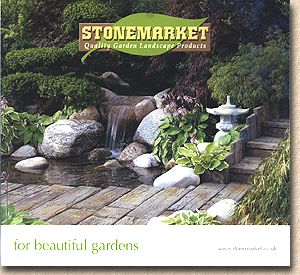Stonemarket 2005
The Stonemarket catalogue is one of the few that I always look forward to with a sense of excitement, because I know it's bound to be good: mouth-watering images, fantastic photography, brilliant staging, and well-considered new products. I know that it's easier to put together such a sumptuous magazine when you've got the resources of a company the size of Stonemarket behind you, but so many other companies could learn from how paving is shown in this catalogue. The emphasis is very much on showing-off the paving, while everything else is background, filler, ephemeral stage dressing that doesn't intrude on the image, but simply enhances the look of the paving - after all, that's what we seek from all these brochures and catalogues: good quality, expressive, detailed photos of the paving, rather than some glossy fantasy lifestyle or underdressed models. There are plenty of other magazines catering to those tastes.
There's a lot to take in with this year's catalogue. 124 pages, including front and back covers and virtually every page includes photos of paving. The inside front cover is an image from last year's award-winning Chelsea garden, and facing that is the Table of Contents, with the products divided into "reconstituted stone" (pronounced as con-crete) and natural stone. All the new items are marked with a leaf symbol, and it's immediately apparent that almost all of the new stuff is in the Natural Stone section, although there are some new Claydale Paviors.
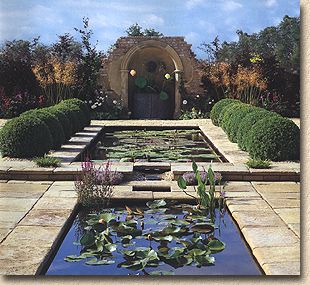
The next page lists Stonemarket's impressive collection of Medals from all of the top RHS Garden shows over the last few years. It's somewhat surprising to note that there's no gold medal. As a keen gardener myself, I've seen many of these gardens, and I can't hep feeling that there's some snobbish discrimination at work here. It's easy to criticise a garden or deduct Brownie points because it has a slight emphasis towards the hard-landscaping, but that's the way many modern gardens are! Most people aren't plantaholics; they want a garden that provides for leisure, relaxation, and simple maintenance, and for that, they usually need a hard surface.
Good quality, well-laid paving and hard-landscaping is as integral to the success of a garden just as much as is the right choice of planting. At many of these shows, I've seen plant-dominated gardens that have almost nowhere to sit and enjoy the garden, that take no account of functionality, and yet they've walked away with Gold medals. Come on, RHS judges - take a wider view and join the rest of us in the real world. We want gardens that work, that present innovative ideas that can be used in the gardens of both grand mansions and humble terraces, and for that, we need decent paving. Credit where credit's due, eh?
</end rant >
There's a handy section on page 5 explaining the essential differences between the various products on the market, and a bar-chart type graphic indicating the comparative total cost of installation for various Stonemarket offerings. This is useful, but I would argue that the cost of installation is not constant for all types of paving. The small Terrascina Tiles take longer to lay, and require a deal more effort, than does laying the Millstone flags, and this will be reflected in the price charged by contractors. Similarly with the natural stone products: laying setts is much more labour-intensive than laying flagstones, and so attracts a higher laying cost.
There's no point in me going through the catalogue page-by-page and offering my thoughts on each product, or we'd be here until next year's catalogue is published, so I intend concentrating on the new products, which, as mentioned, are predominantly natural stone. However, it wouldn't be fair to totally ignore the ... reconstituted stone products. The Millstone remains one of the top 3 reproduction flagstones in the world (what would be your other two??) but the Millstone Walling, particularly the Honey-coloured option, adds a whole extra dimension.
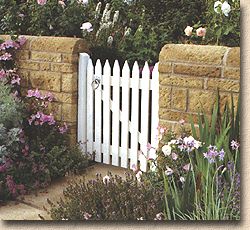
As you flick through the pages, don't just gawp at the images; read the descriptive text, which has been used to fully explain each of the main photos, and note how many 'close-ups' are used to properly illustrate the texture and surface character of the flags. Also, look how different colour options, various sizes and complementary products are shown together. This means each item has the same lighting conditions, which provides a more accurate representation than the individual 'swatches' used in many other brochures.
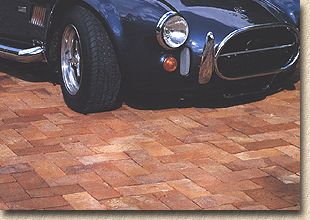
It's page 58 before we reach the first of the new products, the Handmade Claydale Paviors. These won't be to everyone's taste, I admit, but on the right property they will look stunning. There's no other word for them - stunning.
I have a soft spot for clay pavers: I have them in my garden because the colours are so natural and right for my little patch of heaven, but if I was re-doing the patio or the area around the water cascade, I reckon these would be number one item on the shortlist of possible paving materials!
Love 'em!
We're into the natural stone section now. The ever-popular Trustone is still leading the field, augmented this year by the mightily impressive Provence Sunflower that was shown at GLEE last September. I thought it was wonderful back then, but the photo used here really captures the elegance of it all - so much so that it's been used again as the back cover! The basic Sunflower is almost 3m in diameter, but add a ring of complementary flagstone to extend it out to roughly 4m to really give it the setting it deserves. There's an optional Corner Kit, too, for those wanting to fill a rectangular space.

Further additions to the Trustone range include "Ruby", a purpley-red (or is it a reddy-purple?) sandstone that reminds me of Penrhyn slate, although the texture is totally different. I'm not too sure about this. The colour is a little 'in-yer-face' for me, but I know some designers love these stronger hues. There's also "Capital", a 'two-tone' sandstone reminiscent of Highmoor Yorkstone, with distinctive iron banding running through each flag. Gorgeous to look at, but don't ever let any acid-based cleaners near them - hydrochloric acid and iron-rich stone is a recipe for disaster. I'd seriously consider using one of the low-key, unobtrusive sealants for this flag. It would help protect it, for sure, but it would also enhance the gorgeous colouring.
Last new member of the Trustone family is a green-tinged limestone that they're calling "Sage". Very subtle, very stylish, very nice!
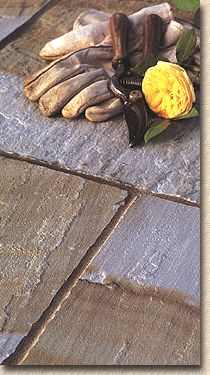

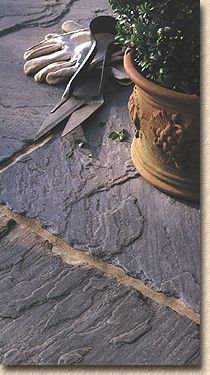
Next up is the "Vintage Stone". This, too, was shown at GLEE and I raved about it. It comes in two colours - a browny-buff natural quartzitic sandstone, and a charcoal-black sandstone with a more definite surface texture that has been dubbed "Raven". Both types have been subjected to a mysterious secondary treatment to give them more of a worn appearance. You'd swear they were reclaimed, so soft and rounded are the edges, arrisses and surface texture. Five modular sizes in the range, so plenty opportunity for random layout. Priced right, this could be a serious challenge to the reclaimed yorkstone flags that are still commanding prices in excess of 40 quid per square metre for quality stone.
And to add to my excitement, there's a range of setts treated in the same way. I haven't seen these in the flesh yet, but I've stuck a Post-it on top of my monitor to remind me to find out more. These are currently only available in the browny-buff colour, and are 140mm wide, with five lengths, ranging from 105mm up to 285mm. Thickness varies from 25-40mm so I'm not sure how well they'd take to screed bedding on sand, but it might be worth trying them on a screeded bed of 10:1 grit sand with cement.
There's also a complementary walling stone, in 3 modular sizes.

Other new stone products include a Travertine, in 3 colours - Gold, Cream and Mushroom. Nice as it is, I'm still not convinced that Travertine is best suited to our climate. There's a dusting of snow outside my window at the moment, and somehow, snow and Travertine don't seem a particularly good mix.


Of more interest to me is the new range of split Granite flags and cropped setts. The flags are available in the classic silver-grey colour, although the smallest of the five sizes (110x110mm) can be had in black, beige and red. I'm disappointed that the largest size is a piddling 440x440mm, but then, these are aimed at the garden-DIY market, and given the Manual Handling regulations, I suppose it's only to be expected. However, there's summat special about larger granite flags, a sense of permanence and solidity that can be lost with smaller units.
The setts are available in the same four colours, but the sizings are a little strange and should be checked before racing ahead with a design.
Larger granite flags are available in the "Arctic" range, although only 600x600mm. These flags come in a light and dark silvery granite that have been dubbed 'Glacier' and 'Dusk'. Both are flame-textured sawn granites, so they're dimensionally accurate and very, very modern in styling. There's only 3 rectangles (600x600, 600x300 and 300x300) although there is also a triangle and a diamond that enable star or harlequin details to be created.
Finally in the natural stone flags, we come to "Marketstone", a price-aware range of imported sandstone flags in 4 popular colours (Buff, Brown, Grey and what Stonemarket call "Sand" but everyone else calls Mint) and 5 sizes, from a chunky 915x610mm to a piddling 305x305mm. Strange sizes, I think, given that most other imported flags are based on the 140mm module (280-420-560-700-840-1120) or a 150mm module (300-450-600-750-900). Why revert to Olde-Worlde imperial dimensions (915x610mm is 3' x 2' in old money)? Has it been done to complement the Millstone flags?
There's a good few additions to the decorative aggregates, including the "Candystone", a sparkly quartzite rock from Norway that was much in evidence at GLEE, along with an improved selection of cobbles, and some new slate "features".
The Design and Technical Info section is a well-presented and informative as ever, with the inimitable 'hand-drawn' look to the layout suggestions that will make the garden designers feel at home. The "How to..." section includes some good pointers for wall building, but the flag-laying page still portrays the abomination that is sp..spo...spot bedding (There! I said it!)

Overall, Stonemarket have produced another excellent catalogue that will be browsed time and time again over the coming months, and will be referred to far more often than some other offerings purely because of the quality of the photos and the sheer number of design ideas presented. It's definitely aimed at the Garden and DIY market, rather than the trade or the contractors, but then, those are our customers, and quality publications such as this can only help contractors sell their ideas and their skills. Nip down to your nearest stockist now and get yourself a copy - you won't be disappointed, and for all the other paving manufacturers out there: read it and weep - this is what a good paving catalogue should look like!
To request a copy of the 2005 Stonemarket catalogue, call their Customer Services Department on 024 7651 8700 or contact them via their website .


